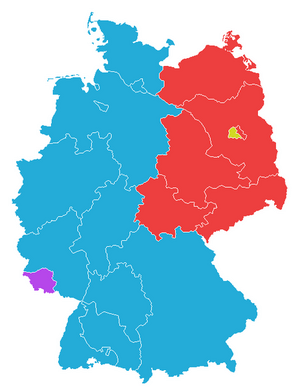German reunification facts for kids

German reunification (in German: Deutsche Wiedervereinigung) is a term from history. It means when two or more parts become one. The German reunification was about joining the two parts of Germany back together.
After World War II, Germany was split into two separate countries. One was the Federal Republic of Germany (FRG), known as "West Germany". The other was the German Democratic Republic (GDR), called "East Germany". German reunification happened on 3 October 1990. On this day, the states of East Germany joined the Federal Republic of Germany.
Contents
Germany Divided: The Cold War Years (1945–1989)
After World War II, the countries that won the war divided Germany into four areas. These were called Allied Occupation Zones in Germany. In 1949, the French, British, and American zones joined to form the Federal Republic of Germany, or "West Germany". The Soviet zone became a separate country called the German Democratic Republic, or "East Germany".
During the Cold War, West Germany was a democratic country. This meant people could elect their Politicians in free elections. It was friends with the United States of America and had a capitalist economic system. In this system, Businesses were owned by regular citizens.
East Germany was a communist country. It was a one-party state, meaning only one political party ruled all the time. Elections were not truly free, and the government owned all businesses. Like other countries in the Soviet bloc, the Soviet Union controlled East Germany.
In the 1950s, West Germany's economy grew very fast. East Germany's economy, however, was not doing well. Because of this, many people moved from East Germany to West Germany. To stop people from leaving, the border between East and West Germany was closed in 1961 by East German forces. This border was part of the Iron Curtain. It was very hard and dangerous to leave East Germany between 1961 and 1989. People who applied to leave officially often had to wait years for approval. The East German police would often spy on them. Many people who tried to escape across the border were shot and killed.
The Berlin Wall Falls (1989)
In 1989, the Soviet leader Mikhail Gorbachev began to open up the Soviet Union to the West. Many other communist countries started to follow his lead. East Germany tried to ignore these changes, but people inside the country began to protest more and more during 1989.
After some attempts to keep the country stable, the border was finally opened on 9 November 1989. East Germany quickly began to change into a democratic country. Over the next 11 months, leaders from East and West Germany, France, Great Britain, the United States, and the Soviet Union talked about how to reunite Germany. They signed the Treaty on the Final Settlement with Respect to Germany, also called the Two Plus Four Treaty. This treaty paved the way for reunification.
Germany Becomes One Again
The West German constitution, called the Grundgesetz, had two ways for reunification to happen:
- Creating a brand new country with a new Constitution.
- Allowing the new federal states from East Germany to join the existing Federal Republic of Germany.
The second option was chosen. On 3 October 1990, at 00:01 (one minute past midnight), five new federal states officially joined the Federal Republic of Germany. These states were Brandenburg, Mecklenburg-Vorpommern, Saxony, Saxony-Anhalt, and Thuringia. The city of Berlin also reunified. At this exact moment, the German Democratic Republic stopped existing.
Related pages
Images for kids
-
Brandenburg Gate in Berlin, a national symbol of today's Germany and its reunification in 1990.
-
1990 Day of German Unity, with flags of all German states at the Reichstag building in Berlin.
-
Erich Honecker, who lost control of East Germany in August 1989.
-
The Berlin Wall at the Brandenburg Gate on 10 November 1989. It shows graffiti saying "Wie denn" ("How now") over a sign warning people they were leaving West Berlin.
-
Police officers of the East German Volkspolizei wait for the official opening of the Brandenburg Gate on 22 December 1989.
-
The Berlin Wall in October 1990, with a message saying "Thank You, Gorbi".
-
The two original copies of the Unification Treaty signed on 31 August 1990. West German Interior Minister Wolfgang Schäuble signed for West Germany, and East German State Secretary Günther Krause signed for East Germany.
-
German people raising the German Flag in front of the Reichstag building in 1990.
-
Soviet leader Mikhail Gorbachev had first wanted a united but neutral Germany.
-
Helmut Kohl became the first chancellor of a reunified Germany.
-
Crowds at the Brandenburg Gate on 1 December 1989. The entrance to the Western side was still closed.
-
East German Prime Minister Hans Modrow, West German Chancellor Helmut Kohl, and West Berlin mayor Walter Momper, among others, at the official opening of the Brandenburg Gate on 22 December 1989.
See also
 In Spanish: Reunificación alemana para niños
In Spanish: Reunificación alemana para niños



















